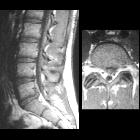Nomenklatur Diskuspathologien
Intervertebral disc disease nomenclature has changed over the years, and a familiarity with current definitions is essential if clear communication is to be achieved via radiology reports or referrals, especially as lumbar disc disease is a common problem and a source of a great deal of imaging. Terms such as bulge, protrusion, extrusion, sequestration and migration all have specific meanings although their definition varies from publication to publication.
The 2014 recommendation from The American Society of Spine Radiology, The American Society of Neuroradiology and The American Spine Society has been widely accepted, and are used in this, and related articles .
Terminology
Disc
The following terms relating to intervertebral discs are recognized . A brief description is included for some; each is then discussed in more detail in separate articles.
- normal
- desiccation
- annular fissure
- disc bulge or bulging: annular tissue projects beyond the margins of the adjacent vertebral bodies, over more than 90 degrees of circumference
- circumferential bulge: involves the entire disc circumference
- asymmetric bulge: does not involving the entire circumference, but more than 90 degrees
- herniation
- protrusion: focal herniation of disc material beyond margins of adjacent vertebral body, over less than 90 degrees of circumference, with a base that is wider than dome
- extrusion: focal herniation of disc nuclear material through an annular defect, remaining in continuity with the disc, with a base narrower than the dome of the extrusion
- sequestration: distal migration of extruded disc material away from the disc, with no direct continuation with the adjacent disc
- pseudodisc of anterolisthesis: deformity of annular fibers due to anterolisthesis mimicking a true protrusion or bulge
Localization
In the case of disc herniation then the abnormally displaced nucleus pulposus should be described in terms of its position in both axial and sagittal planes.
Axial localization
Disc herniations are localized in the axial plane into several zones:
- central, including paracentral (more precisely, right central or left central)
- subarticular, including lateral recess (subarticular zone at the pedicular level)
- foraminal, also known as lateral (nonstandard)
- extraforaminal, also known as lateral (nonstandard) or far lateral
- anterior
Sagittal localization
The pedicle and disc are used as reference points for craniocaudal localization on sagittal images:
- disc level: confined to between the vertebral endplates
- suprapedicular: between superior endplate and the superior border of pedicle
- pedicular: at the level of the pedicle
- infrapedicular: below lower margin of the pedicle to the inferior endplate
Siehe auch:
- Bandscheibenprotrusion
- Diskusprolaps
- Bandscheibenextrusion
- lumbar disc disease
- annular fissure
- herniation
- Bandscheibe
- bulge of intervertebral disc
- desiccation of intervertebral disc
und weiter:

 Assoziationen und Differentialdiagnosen zu Nomenklatur Diskuspathologien:
Assoziationen und Differentialdiagnosen zu Nomenklatur Diskuspathologien:



